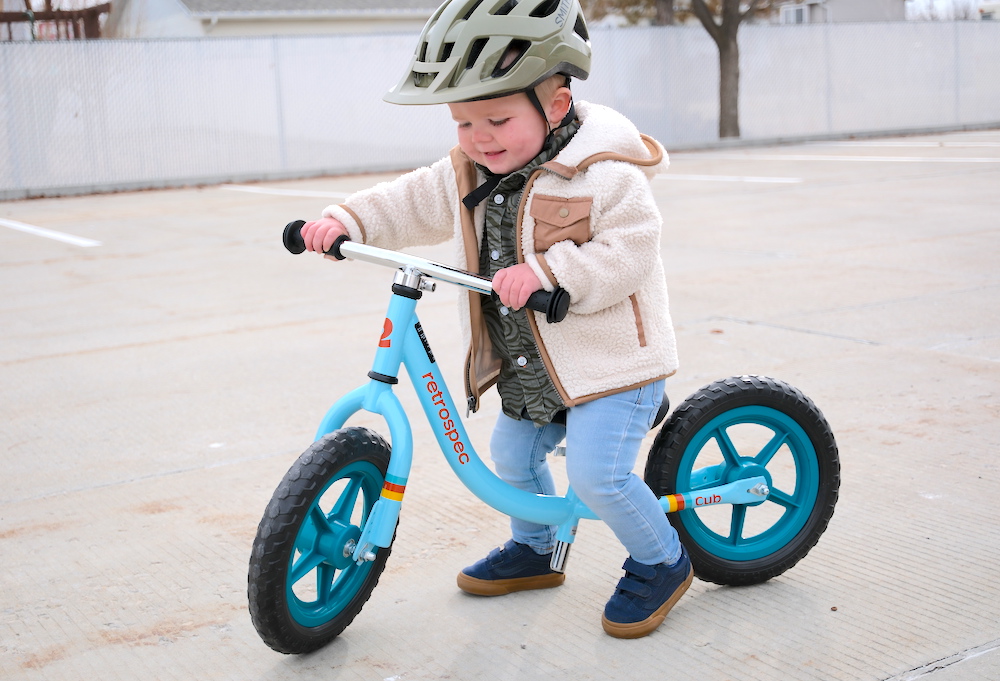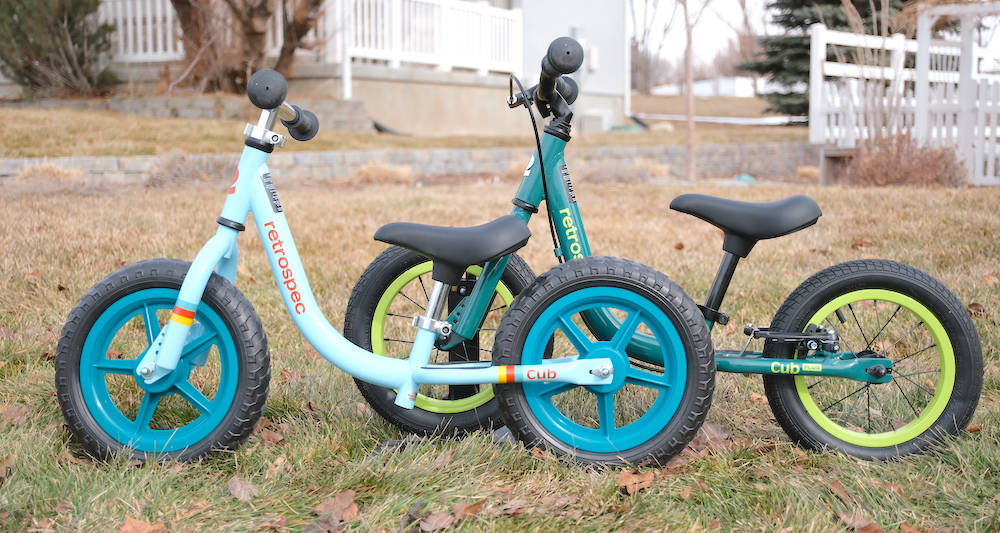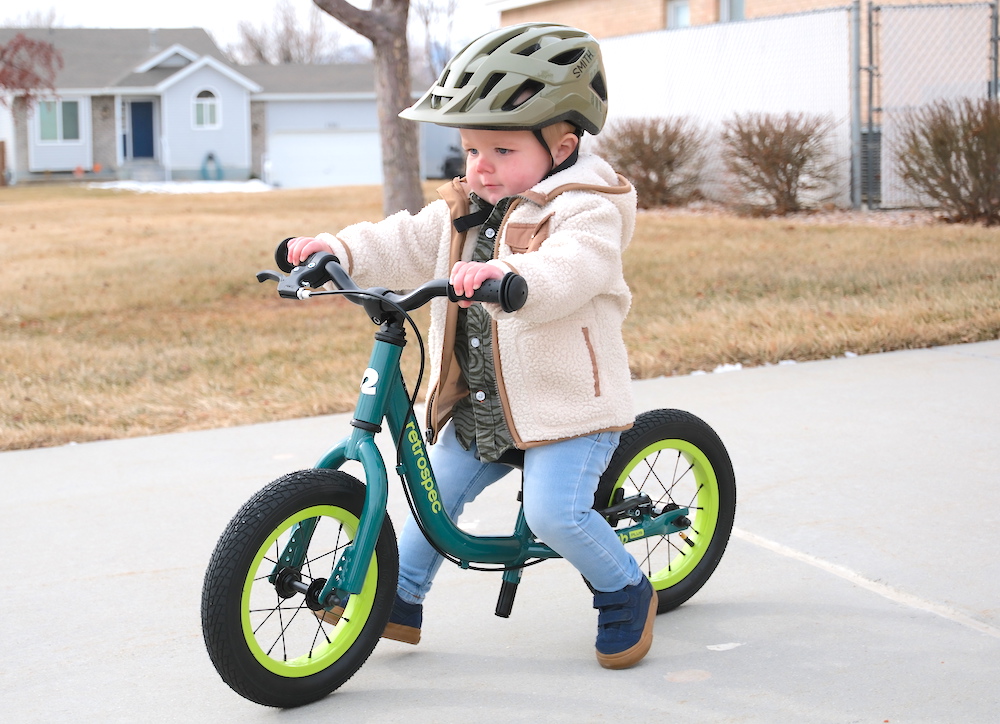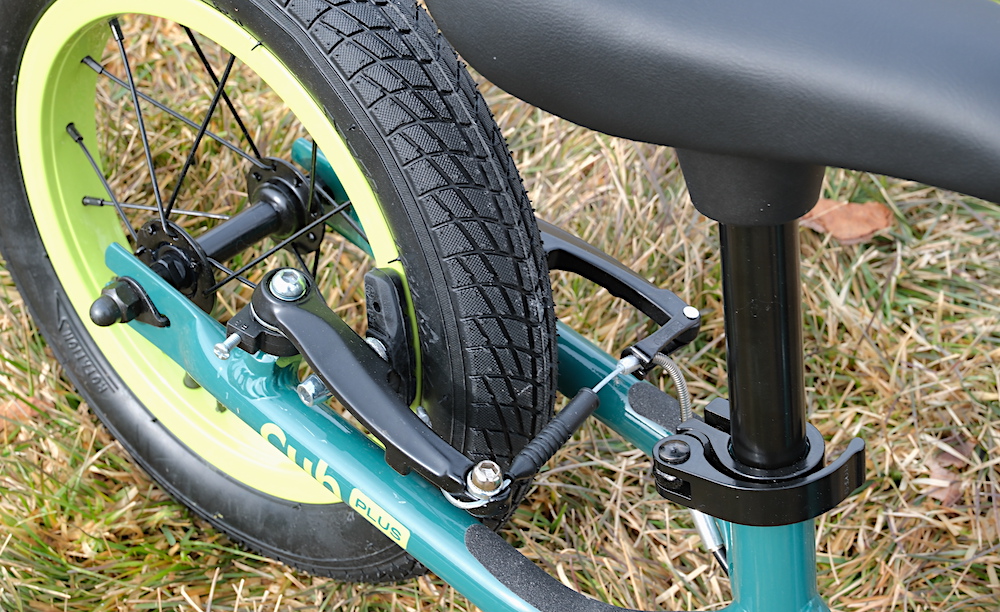Completely overhauled and updated, the 2023 Retrospec Cub balance bike offers modern style and great geometry at an impressive price point. Available in two models, the “Cub 2” and the upgraded “Cub Plus 2”, both bikes have the same frame design, but the Plus features several upgrades, including air tires and a handbrake.
We put both models of the Cub to the test and were quite impressed with the Cub’s performance and quality for the price. In this review, we’ll cover everything you need to know about the Retrospec Cub balance bikes including the differences between the two models.

Retrospec Cub 2 Balance Bike

RATING: Highly Recommended
MSRP: Cub 2: $69, Cub Plus 2: $109
BEST FOR: Families looking for a quality balance bike on a budget. The Cub is a great buy for toddlers sticking to paved surfaces, while the Cub Plus is better for all-terrain use as well as for more aggressive riders.
SEAT HEIGHT (both): 11.5″ – 15″
WEIGHT: Cub: 7 lb., Cub Plus: 8.7 lb.
WHEELS: Cub: Foam on plastic rims, Cub Plus: Air on metal rims
BRAKE: Cub: None, Cub Plus: Handbrake
FRAME: Cub: Steel, Cub Plus: Aluminum
PROS:
- Cute and colorful, modern designs
- Lower minimum seat height than most budget balance bikes
- Great, kid-friendly geometry
- Height adjustable handlebars and seat offer plenty of room for growth on both models
- Cub Plus features quality air tires on sturdy metal rims as well as a handbrake
- Quick release seat post clamp (both models)
- Properly placed footrest is there for kids who want it, but out of the way for those who don’t
CONS:
- Seat and handlebar quick-release clamps on the Cub don’t hold very tight
- Hand brake on the Cub Plus 2 is harder to engage than other bikes
- Minimum handlebar is too high on the Cub Plus for small riders
Retrospec Cub Balance Bike Review
It’s not very often that a balance bike gets a complete re-haul from top to bottom, so we were excited to test out the newly updated Cub 2 balance bikes from Retrospec.
Their old Cub model needed a few important changes, and Retrospec has certainly been doing their homework as the new Cub 2 is a completely different beast in all the right ways. From fit to performance, we quickly found a lot to love about these new Retrospec balance bikes.

What size child fits on the Cub?
Both models of the Cub have a seat height range of 11.5″ to 15″. With a minimum seat height slightly lower than many balance bikes, the Cub is able to fit kids as young as 18-months.
Our tester shown below is 20 months old in 24 month pants with a 13.5″ inseam. He is riding the Cub Plus with the saddle set to its minimum seat height of 11.5″.

The minimum seat height of 11.5″ on the Cub is particularly notable as it is one of the lowest minimum seat heights found on a budget-friendly balance bike. As a result, our young tester was able to ride the Cub without any concerns, but was too short to ride other popular budget bikes such as the Banana Bike GT (min seat 12.5″), Swagtron K3 (12.25″) and the Radio Flyer Air Ride (13″).
On the high end, the Cub’s max seat height of 15″ allows for 3.5″ of leg growth, allowing for approximately 1.5 to 2 years of an optimal fit, which is pretty standard for most balance bikes.
During those 2ish years, however, both Cub models do a phenomenal job in properly growing with the child as the height of the handlebars are just as adjustable as the height of the seat.

Improved Frame Design Helps Balance and Handling
In addition to having a lower minimum seat height, the frame design of the Cub 2 and Cub Plus 2 allows them to have a longer wheelbase compared to other balance bikes. Both Cub models have a wheelbase of 23.5″, creating more space and allowing the weight of the rider to be properly centered and balanced on the bike, even when the seat and handlebars are raised for older riders.
In fact, the Cub provides a similar amount of space in the cockpit (the space between the rider’s body and the bike’s handlebars) as the high-end woom 1.

Many budget balances bikes are much smaller and have shorter wheelbases, which leads to a shorter, cramped cockpit. This can negatively affect a child’s balance as well as the handling of the bike. For example, the Chillafish Charlie balance bike (11″ – 14.1″ seat height range) is designed for the same size child as the Cub, but its wheelbase is 3.5″ shorter at only 19″!
What is the difference between the Cub 2 and the Cub Plus 2?
While both the Cub 2 and Cub Plus 2 fit the same size child, they vary greatly in components and quality. The model that is best for your toddler depends on where they plan on riding, as well as how aggressive or adventurous you anticipate them becoming on their bike. The more varied terrain or more adventurous your rider, the more likely you should go for the Cub Plus versus the Cub.
Wheels and Tires – Foam vs Air
The Cub 2 has puncture-proof foam tires on plastic rims, while the Cub Plus 2 has air tires on painted metal rims. Both tires have their pros and cons.
The foam tires on the Cub will never go flat and are essentially maintenance free, but they provide no cushioning and offer less traction that the air tires on the Cub Plus.
The rubber air tires on the Cub Plus can go flat, but their cushioning properties will help smooth out the bumps in the sidewalk and pavement, while also providing more traction on mixed terrains.

For the average toddler riding on paved surfaces around the neighborhood, the foam tires work just fine, but for more adventurous riders we strongly feel that the air tires are worth the additional expensive. From jumping off curbs to cruising through the grass or dirt paths, the extra traction provided by air tires are sure to be put to good use.
Handbrake on Cub Plus 2 Only
Considering handbrakes are rarely found on balance bikes under $199, the Cub Plus is pretty unique. While young toddlers will primarily use their feet to stop a balance bike, as they get older and improve their hand – eye coordination, many older toddlers are able to start using a handbrake as well.
In addition to stopping faster and with more control, handbrakes on balance bikes are fabulous as they prevent kids from quickly wearing out the soles of their shoes!
The braking mechanism on the Cub Plus is properly placed above the bike’s rear chainstays to prevent any interference with the child’s stride. As a result, the brake is there when needed, but safely tucked away otherwise.

While the brake works great when pulled firmly, unfortunately our young testers found the brake lever challenging to pull. After some adjusting, we were able to ease the tension on the brake cable, but the brake lever on the Cub Plus 2 is certainly stiffer and harder for kids to pull compared to higher-end balance bikes.
For some kids, the stiffness of the brake is likely to limit their use of the brake. That being said, if you have room in your budget to get the Cub Plus over the Cub, we still recommend doing so.

On a side note, both the Cub and the Cub Plus have the same grips as shown above. In addition to being soft and grippy, we love that they contain a stiff bumper at the end to help protect small hands in the event of a crash.
Adjustable Height Handlebars
The Cub has straight handlebars while the Cub Plus’s have a slight rise to them. As a result, the lowest position of the handlebars on the Cub is slightly lower than than on the Cub Plus.

For taller or older riders who will likely raise the handlebars anyway, the minimum handlebar height is likely a moot point, but considering our young tester was riding the Cub and the Cub Plus at the minimum seat height of 11.5″, the difference in handlebar height was noticeable.
If your rider will be using the balance bike at its minimum seat height, it’s certainly something to consider. While riding the Cub Plus with the handlebars set to their lowest setting (shown on the right in the image above), our young tester was required to ride with his arm straight out, versus slightly downward on the Cub.
A downward angle of the arms from the shoulders to the grips (similar to the position shown on the Cub on the left) is preferred as it allows the rider to place more weight on the front tire which aides in maneuverability and steering.
Considering our tester has only been riding balance bikes for a month or so, his more relaxed riding style didn’t require quick turns or intricate weaving, so he did not seem bothered by the higher placed handlebars of the Cub Plus.
Given that young riders grow very quickly, we don’t anticipate the taller minimum handlebar height of the Cub Plus to be problematic for most young riders and wouldn’t consider this a reason to purchase the Cub over the Cub Plus.
Headset – Cub Plus 2 Offers Firmer Grip
Where the handlebars attach to the frame of the bike also differs between the models. The handlebars of the Cub are attached via a simple quick-release clamp (shown on the left below), while the Club Plus has a steel threaded headset (on the right).

The quick-release clamp of the Cub allows for tool-free adjustments on the go, but doesn’t hold the handlebars in place very firmly, resulting in the handlebars having to be realigned with the front wheel quite often. The steel threaded headset on the Cub Plus holds the handlebars firmly in place, but does require an Allen wrench to raise the bars.
Weight and Frame
The frame design of the two models is the same, except for the material of their construction. The Retrospec Cub’s frame is constructed of steel, while the Cub Plus is made of rust-proof aluminum. The only noticeable difference between the two frames is that the Cub Plus has mounts for the handbrake while the Cub’s does not.

Although aluminum frames are typically lighter than steel frames, the added features of the Cub Plus (upgraded wheels, brake, headset), make it heavier (8.7 lb.) compared to the more basic Cub (7 lb.).
At 8.7 lb., the Cub Plus is heavier than similarly-priced bikes such as the Strider (6.4 lb.) and the Radio Flyer (8.2 lb.), but it is the only bike in its price range to have air tires and a hand brake.
How does the Cub compare to other budget balance bikes?
The Retrospec Cub 2 and the Cub Plus 2 both offer amazing value for the price point. Compared to similarly-priced balance bikes, both Cubs stand out amongst the crowd for their fun and modern color combinations, kid-friendly frame geometry and height adjustability, while the Cub Plus steps it up with air tires and a handbrake.
| Cub 2 | Cub Plus 2 | Strider Classic | Banana Bike GT | |
| MSRP | $69 | $109 | $99 | $79 |
| Weight | 7 lb. | 8.7 lb. | 6.4 lb. | 8.1 lb. |
| Seat Height | 11.5″ – 15″ | 11.5″ – 15″ | 11″ – 16″ | 12.5″ – 17″ |
| Tires | Foam | Air | Foam | Air |
| Footrest | Yes | Yes | Yes | No |
| Brakes | No | Yes | No | No |
| # of colors | 8 | 2 | 4 | 3 |
| Link to Review | – | – | Strider Classic | Banana Bike |
What to I gain by bumping up my budget to get the Strider Classic?
The Strider Classic is a solid-quality balance bike that has been around for years, and for good reason. Benefits of going with the Strider Classic over the Retrospec Cub 2 include:
- Greater seat height range – The Strider Classic offers a 5″ seat height range while the Cub 2 offers 3.5″. While minimal, those extra inches will certainly extend your child’s proper fit window on their balance bike.
Strider’s extended seat post can also boost the maximum seat height to 19″. **While we have not tried it ourselves, according to the specs provided by Strider and Retrospec, the extended seat post offered by Strider should also fit on the Cub (both have a seat post diameter of 22.2mm)** - The ability to upgrade the bike – Strider offers multiple add-on accessories including air tires, an extended seat post, and skis
- Higher resale value – The Strider is a known name that many people will pay more for second hand
What do I gain by getting the Retrospec Cub 2 over the Strider Classic?
- Multiple modern color options – The Cub 2 comes in 8 different color combinations. Strider’s color options vary, but they typically have 4 solid color options in the Classic model.
- Padded Saddle – The Strider Classic has a hard plastic saddle, while the Cub 2’s is padded. Strider’s hard saddle typical isn’t an issue until kids are potty trained and out of diapers. Strider’s upgraded model, the Strider Sport, comes with a paddle saddle as well as the extended seat post.
Retrospec Cub 2 Balance Bike Bottom Line
Offering great styling, fit, and performance for a low price point, the Retrospec Cub and Cub Plus balance bikes should be on the list for any budget-minded parent. With a minimum seat height of 11.5″, both Cubs are a great option for young toddlers ready to get started on their balance bike journey.
With foam tires, the Cub is better suited for young rider sticking to the pavement, while the air tires of the Cub Plus make it better suited for toddlers adventuring through varied terrains as well as taking on small jumps.
FTC Disclosure: Affiliate links are included in this review. No monetary compensation was provided for this review. All opinions and images are that of Two Wheeling Tots LLC. All content and images are copyrighted and should not be used or replicated in any way. View our Terms of Use.
